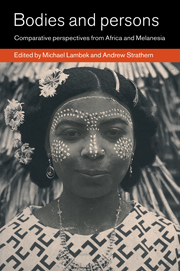Book contents
- Frontmatter
- Contents
- List of illustrations
- List of contributors
- Acknowledgments
- 1 Introduction: Embodying sociality: Africanist–Melanesianist comparisons
- Part I Transcending dichotomies
- Part II Transitions, containments, decontainments
- Part III From exchange to history
- 9 Creative possessions: spirit mediumship and millennial economy among Gebusi of Papua New Guinea
- 10 Dis-embodiment and concealment among the Atbalmin of Papua New Guinea
- 11 Melpa and Nuer ideas of life and death: the rebirth of a comparison
- 12 Afterword: embodying ethnography
- Bibliography
- Index
10 - Dis-embodiment and concealment among the Atbalmin of Papua New Guinea
Published online by Cambridge University Press: 05 June 2012
- Frontmatter
- Contents
- List of illustrations
- List of contributors
- Acknowledgments
- 1 Introduction: Embodying sociality: Africanist–Melanesianist comparisons
- Part I Transcending dichotomies
- Part II Transitions, containments, decontainments
- Part III From exchange to history
- 9 Creative possessions: spirit mediumship and millennial economy among Gebusi of Papua New Guinea
- 10 Dis-embodiment and concealment among the Atbalmin of Papua New Guinea
- 11 Melpa and Nuer ideas of life and death: the rebirth of a comparison
- 12 Afterword: embodying ethnography
- Bibliography
- Index
Summary
In the early to middle 1980s I carried out research among the Atbalmin, a people who live in a remote mountainous area of Papua New Guinea. At that time, the Atbalmin had recently converted to Christianity, but they still continued to depend on indigenous social, economic, and religious practices. In the area where I lived, there was a continuous debate over whether to preserve or destroy a particularly important temple. The temple had been for generations the center of a complex system of rituals, myths, and objects from which women were largely excluded and to which men gained access only through a long series of initiation ceremonies. Many people believed that keeping the temple was a great sin which would ensure that they would burn in Hell forever. Others felt strongly that the temple was of key importance and that its destruction would endanger their lives and society.
What makes this debate among a New Guinea people relevant for the topic of this volume is that it was deeply about persons and bodies. Defenders and opponents of the Bomtem temple alike shared the view that people, individually and collectively, were at risk and needed help. The threat was expressed in terms of its negative effects on the body: grotesque Christian scenes of torture in Hell, and equally terrifying indigenous forebodings of sickness, starvation, and loss of bodily capacities. Both sides emphasized that the threat came from a concealed source that they had a special means of revealing and responding to.
- Type
- Chapter
- Information
- Bodies and PersonsComparative Perspectives from Africa and Melanesia, pp. 210 - 231Publisher: Cambridge University PressPrint publication year: 1998
- 1
- Cited by



